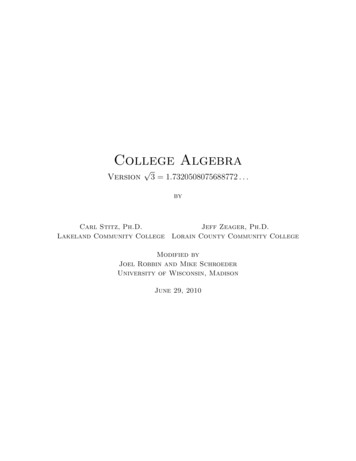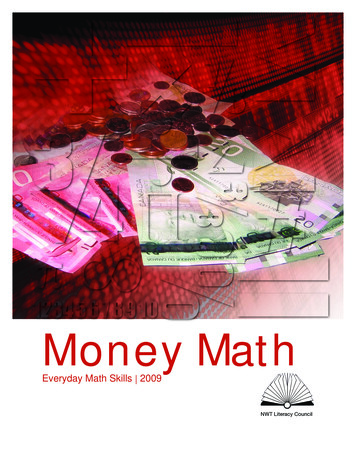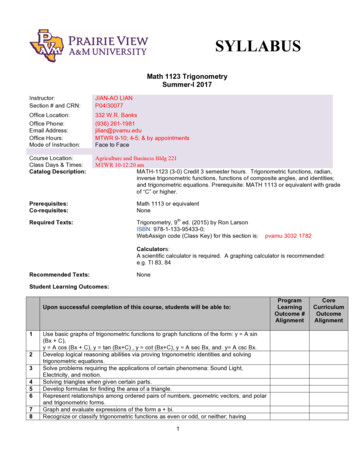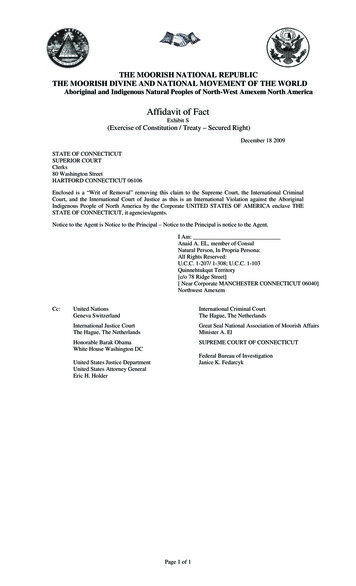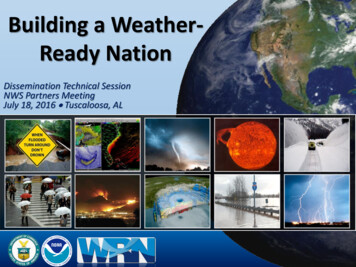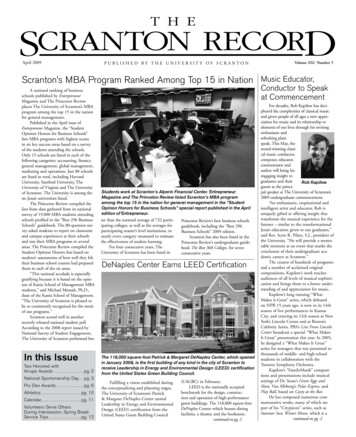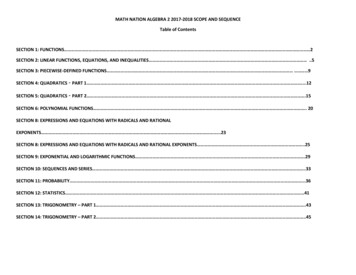
Transcription
MATH NATION ALGEBRA 2 2017-2018 SCOPE AND SEQUENCETable of ContentsSECTION 1: FUNCTIONS 2SECTION 2: LINEAR FUNCTIONS, EQUATIONS, AND INEQUALITIES .5SECTION 3: PIECEWISE-DEFINED FUNCTIONS 9SECTION 4: QUADRATICS ‑ PART 1 .12SECTION 5: QUADRATICS ‑ PART 2 .15SECTION 6: POLYNOMIAL FUNCTIONS . 20SECTION 8: EXPRESSIONS AND EQUATIONS WITH RADICALS AND RATIONALEXPONENTS .23SECTION 8: EXPRESSIONS AND EQUATIONS WITH RADICALS AND RATIONAL EXPONENTS .25SECTION 9: EXPONENTIAL AND LOGARITHMIC FUNCTIONS .29SECTION 10: SEQUENCES AND SERIES .33SECTION 11: PROBABILITY .36SECTION 12: STATISTICS 41SECTION 13: TRIGONOMETRY – PART 1 .43SECTION 14: TRIGONOMETRY – PART 2 .45
SECTION 1: FUNCTIONS 7 Days (Includes 1 Day for Baseline) August 14 – August 31Topic12534TitleAdding FunctionsMultiplyingFunctionsCompositions ofFunctionsDividing RationalExpressionsUsing SyntheticDivision to DivideFunctionsStandardsMAFS.912.A-APR.1.1 Understand thatpolynomials form a system analogous to theintegers, namely, they are closed under theoperations of addition, subtraction, andmultiplication; add, subtract, and multiplypolynomials.MAFS.912.A-APR.1.1 Understand thatpolynomials form a system analogous to theintegers, namely, they are closed under theoperations of addition, subtraction, andmultiplication; add, subtract, and multiplypolynomials.MAFS.912.F-BF.1.1c Write a function thatdescribes a relationship between two quantities.c. Compose functions. For Problem, if (𝑦) is thetemperature in the atmosphere as a function ofheight and ℎ(𝑡) is the height of a weather balloonas a function of time, then 𝑇(ℎ(𝑡)) is thetemperature at the location of the weatherballoon as a function of time.MAFS.912.A-APR.4.6 Rewrite simple rationalexpressions in different forms; write 𝑎(𝑥)/𝑏(𝑥) inthe form 𝑞(𝑥) 𝑟(𝑥)/𝑏(𝑥), where 𝑎(𝑥), 𝑏(𝑥), 𝑞(𝑥),and 𝑟(𝑥) are polynomials with the degree of 𝑟(𝑥)less than the degree of 𝑏(𝑥), using inspection,long division, or, for the more complicatedProblems, a computer algebra system.MAFS.912.A-APR.4.6 Rewrite simple rationalexpressions in different forms; write 𝑎(𝑥)/𝑏(𝑥) inthe form 𝑞(𝑥) 𝑟(𝑥)/𝑏(𝑥), where 𝑎(𝑥), 𝑏(𝑥), 𝑞(𝑥),ObjectiveIn this topic, studentswill add and subtractpolynomial functions.In this topic, studentswill multiply polynomialfunctions.In this topic, students willwrite a function to modela real-world context bycomposing functions andthe information withinthe context.In this topic, students willrewrite a rationalexpression as thequotient in the form of apolynomial added to theremainder divided by thedivisor. Students will usepolynomial long divisionto divide a polynomial bya polynomial.In this topic, students willuse synthetic division as amethod of rewritingPearson TextbookCorrelationDaysNeededp. 399 Section 6-6FunctionoperationsProblem 1p. 399 Section 6-6FunctionoperationsProblem 2Day 1(8/14 – 15)p.400 Section 6-6Problems 3,4p.303 Section 5-4DividingPolynomialsProblems 1, 2Day 2(8/16 – 17)p.303 Section 5-4Dividing
and 𝑟(𝑥) are polynomials with the degree of 𝑟(𝑥)less than the degree of 𝑏(𝑥), using inspection,long division, or, for the more complicatedProblems, a computer algebra system.6789Inverse Functions –Part 1Inverse Functions –Part 2Recognizing Evenand Odd FunctionsKey Features ofGraphs ofFunctionsMAFS.912.F-BF.2.4a,c Find inverse functions.a. Solve an equation of the form (𝑥) 𝑐 for asimple function,𝑓, that has an inverse and writean expression for the inverse.For Problem, 𝑓 𝑥 2 3 or (𝑥) (𝑥 1)/(𝑥– 1) for 𝑥 1.c. Read values of an inverse function from a graphor a table, given that the function has an inverse.MAFS.912.F-BF.2.4a,b,c,d Find inverse functions.a. Solve an equation of the form (𝑥) 𝑐 for asimple function,𝑓, that has an inverse and writean expression for the inverse.For Problem, 𝑓 𝑥 2 3 or (𝑥) (𝑥 1)/(𝑥– 1) for 𝑥 1.b. Verify by composition that one function is theinverse ofanother.c. Read values of an inverse function from a graphor a table, given that the function has an inverse.d. Produce an invertible function from a noninvertible function by restricting the domain.MAFS.912.F-BF.2.3 Identify the effect on thegraph of replacing 𝑓(𝑥) by 𝑓(𝑥) 𝑘, 𝑘𝑓(𝑥), 𝑓(𝑘𝑥),and 𝑓(𝑥 𝑘) for specific values of k (both positiveand negative); find the value of k given thegraphs. Experiment with cases and illustrate anexplanation of the effects on the graph usingtechnology. Include recognizing even and oddfunctions from their graphs and algebraicexpressions for them.MAFS.912.F-IF.3.7a Graph functions expressedsymbolically and show key features of thegraph, by hand in simple cases and usingrational expressions whenthe divisor is in the form𝑥 𝑐.In this topic, studentswill investigate inversefunctions. will use agraph or a table of afunction to determinevalues of the function’sinverse.Students will find theinverse of a function.PolynomialsProblems 3, 4one-to-one: p.408Section 6-6 notesvertical line test:p.62-63 Section 2-1Problem 4p.405 Section 6-7Problems 1, 2, 3p.405 Section 6-7Problems 1, 2, 3, 4In this topic, students willcontinue to work withinverses. Students willuse compositions todetermine if twofunctions are inverses.Students will restrictdomains to createinvertible functions.In this topic, students willinvestigate features ofeven and odd functions.Students will determine iffunctions are even orodd by examiningequations, tables, andgraphs.In this topic, students willreview key features ofgraphs of functions.Day 3(8/18 – 21)p.283 Section 5-1problems 2, 3Day 4(8/22-23)Domain/Rangep.61-62 Section 2-1note/Problems 2, 3
technology in more complicated cases. A.Graph linear and quadratic functions and showintercepts, maxima, and minima. This sectionfocuses on linear functions.1011Transformations ofFunctions – Part 1Transformations ofFunctions – Part 2MAFS.912.F-IF.2.4 For a function that models arelationship between two quantities, interpretkey features of graphs and tables in terms of thequantities, and sketch graphs showing keyfeatures given a verbal description of therelationship. Key features include: intercepts;intervals where the function is increasing,decreasing, positive, or negative; relativemaximums and minimums; symmetries; endbehavior; and periodicity.MAFS.912.F-BF.2.3 Identify the effect on thegraph of replacing 𝑓(𝑥) by 𝑓(𝑥) 𝑘, 𝑘𝑓(𝑥), 𝑓(𝑘𝑥),and 𝑓(𝑥 𝑘) for specific values of k (both positiveand negative); find the value of k given thegraphs. Experiment with cases and illustrate anexplanation of the effects on the graph usingtechnology. Include recognizing even and oddfunctions from their graphs and algebraicexpressions for them.MAFS.912.F-BF.2.3 Identify the effect on thegraph of replacing 𝑓(𝑥) by 𝑓(𝑥) 𝑘, 𝑘𝑓(𝑥), 𝑓(𝑘𝑥),and 𝑓(𝑥 𝑘) for specific values of k (both positiveand negative); find the value of k given thegraphs. Experiment with cases and illustrate anexplanation of the effects on the graph usingtechnology. Include recognizing even and oddfunctions from their graphs and algebraicexpressions for them.(solutions, ng,maximum, minimum,).In this topic,students willreviewtransformations offunctions.Students will investigatehorizontal shifts offunctions. Students willalso consider multipletransformations on afunction.In this topic,students willreviewtransformations offunctions.Students will investigatehorizontal shifts offunctions. Students willalso consider multipletransformations on afunction.Solutions, Zeros orRoots:p.76 Section 2-3notes.p.266 Section 4-5Introp.299 Section 5-3Problem 3Beat the Test –Introduction toPiece-wiseFunctions p.90 – 91Concept Byte 2-4p.99 Section 2-6Problems 1 – 4Day 5(8/24-25)Linear:p.99 Section 2-6Problems 1 – 4Exponential:p.442 Section 7-2Problems 1, 2Quadratic:p.144 Section 4-1Problems 1,2
12ComparingFunctionsAReview andAssessmentsBaselineMAFS.912.F-IF.3.9 Compare properties of twofunctions each represented in a different way(algebraically, graphically, numerically in tables,or by verbal descriptions). For Problem, given agraph of one quadratic function and an algebraicexpression for another, say which has the largermaximum.In this video, students willcompare the features ofall the functionspreviously studied.Not in currentvideo listDay 6/7(8/28-29)1 Day
SECTION 2: Linear Functions, Equations and Inequalities 7 Days September 1 – September 21TopicTitleStandardsMAFS.912.A-CED.1.1 Create equations andinequalities in one variable and use them tosolve problems.MAFS.912.A-REI.1.1 Explain each step in solvinga simple equation as following from the equalityof numbers asserted at the previous step,starting from the assumption that the originalequation has a solution.123Linear Equations inOne Variable –Part 1Linear Equations inOne Variable –Part 2Linear Equationsand Inequalities inTwo VariablesMAFS.912.A-REI.1.2 Solve simple rational andradical equations in one variable, and giveexamples showing how extraneous solutionsmay arise.MAFS.912.A-SSE.1.1a Interpretexpressions that represent a quantity interms of its context.a. Interpret parts of an expression, such as terms,factors, and coefficients.MAFS.912.A-CED.1.4 Rearrange formulas tohighlight a quantity of interest using the samereasoning as in solving equations.MAFS.912.A-CED.1.1 Create equations andinequalities in one variable and use them to solveproblems.MAFS.912.A-CED.1.2 Create equations in two ormore variables to represent relationshipsbetween quantities; graph equations oncoordinate axes with labels and scales.ObjectivePearson TextbookCorrelationDaysNeededp.26 Section 1-4Problems 1-4In this topic, students willjustify the steps to solveequations. Students willcreate and solveequations representingreal-world situations.Additionally, students willinterpret expressionsand what the termsrepresent.Day 1(9/1-5)In this topic, students willsolve equations withmultiple variables for aspecific variable.I In this topic, studentswill represent real-worldsituations with linearfunctions. Students willgraph the functions andp.26 Section 1-4Problem 5p.60 Section 2-1Problem 6p.74 Section 2-3Problems 1 – 4
MAFS.912.A-CED.1.3 Represent constraints byequations or inequalities and by systems ofequations and/or inequalities, and interpretsolutions as viable or nonviable options in amodeling context.interpret key features ofthe graph.p.114 Section 2-8Problems 1, 2MAFS.912.F-LE.2.5 Interpret theparameters in a linear or an exponentialfunction in terms of a context.45Key Features ofLinear FunctionsClassifying LinearFunctions andFinding InversesMAFS.912.A-SSE.1.1a Interpretexpressions that represent a quantity interms of its context.a. Interpret parts of an expression, such as terms,factors, and coefficients.MAFS.912.F-IF.2.4 For a function that models arelationship between two quantities, interpretkey features of graphs and tables in terms of thequantities and sketch graphs showing keyfeatures given a verbal description of therelationship. Key features include: intercepts;intervals where the function is increasing,decreasing, positive, or negative; relativemaximums and minimums; symmetries; endbehavior; and periodicity.MAFS.912.F-BF.2.4 Find inverse functions.a. Solve an equation of the form f(x) c for asimple function, f, that has an inverse andwrite an expression for the inverse. Forexample, 𝑓(𝑥) 2𝑥³ or 𝑓(𝑥) (𝑥 1)/(𝑥– 1)for 𝑥 1.b. Verify by composition that one function isthe inverse of another.c. Read values of an inverse function from agraph or a table, given that the function hasan inverse.d. Produce an invertible function from anon-invertible function by restricting thep.81 Section 2-4Problem 4In this topic, students willreview the key featuresof linear functions.p.407 Section 6-7Problem 1In this topic, students willclassify linear functionsas even, odd, or neither.Additionally, students willfind the inverse of alinear function, if itexists.Day 2(9/6 – 7)
domain.678Solving LinearSystems InvestigatingGraphing,Substitution, andEliminationSolving LinearSystems UsingEliminationSolving LinearSystems UsingSubstitutionMAFS.912.A-REI.3.6 Solve systems of linearequations exactly and approximately (e.g., withgraphs), focusing on pairs of linear equations intwo variables.MAFS.912.A-REI.4.11 Explain why thex-coordinates of the points where the graphs ofthe equations 𝑦 𝑓(𝑥) and 𝑦 𝑔(𝑥) intersectare the solutions of the equation 𝑓(𝑥) 𝑔(𝑥); findthe solutions approximately (e.g., usingtechnology to graph the functions, make tables ofvalues, or find successive approximations).MAFS.912.A-REI.3.6 Solve systems of linearequations exactly and approximately (e.g., withgraphs), focusing on pairs of linear equations intwo variables.MAFS.912.A-CED.1.2 Create equations in two ormore variables to represent relationshipsbetween quantities; graph equations oncoordinate axes with labels and scales.MAFS.912.A-SSE.1.1a Interpretexpressions that represent a quantity interms of its context.a. Interpret parts of an expression, such as terms,factors, and coefficients.MAFS.912.A-CED.1.2 Create equations in two ormore variables to represent relationshipsbetween quantities; graph equations oncoordinate axes with labels and scales.MAFS.912.A-REI.3.6 Solve systems of linearequations exactly and approximately (e.g., with
12 Comparing Functions MAFS.912.F-IF.3.9 Compare properties of two functions each represented in a different way (algebraically, graphically, numerically in tables, or by verbal descriptions).
